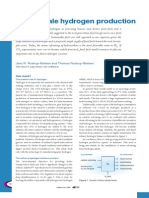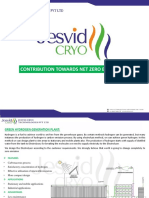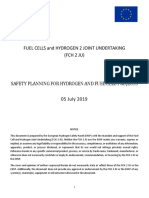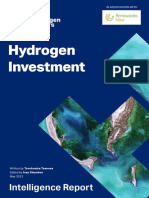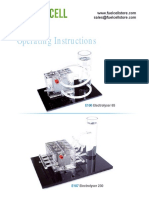H2 Standards 1694532522
H2 Standards 1694532522
Uploaded by
balasundarCopyright:
Available Formats
H2 Standards 1694532522
H2 Standards 1694532522
Uploaded by
balasundarOriginal Title
Copyright
Available Formats
Share this document
Did you find this document useful?
Is this content inappropriate?
Copyright:
Available Formats
H2 Standards 1694532522
H2 Standards 1694532522
Uploaded by
balasundarCopyright:
Available Formats
Join Our 101 days Advanced Hydrogen
Table of Content Page no
Executive Summary 02
1. Prevailing Standards in India for Gases and Fuels. 03
2. International Scenario for H2 Standards. 06
• National and International bodies who are developing 06
standards related to hydrogen and its applications
• Status of international standards and its scope 07
• Status of Hydrogen standards in India 09
• An overview of the existing standards adopted in India 11
• Summary of Hydrogen standards in India vs abroad 12
3. Recommendations for Indian Hydrogen Standard 15
4. Announcement of Standards by India on Green Hydrogen Emission 16
5. Major Gaps 17
6. Way Forward 18
Join Our 101 days Advanced Hydrogen Program
2
Executive Summary
Standards and regulatory framework for liquid fuels and gases have evolved, matured and
become stable in India over past five to six decades. Research institutions have formulated
the standards, regulatory bodies have enforced those and market has accepted. India has
standards and specifications for all fuels including gaseous fuels like LPG, CNG and LNG. India
also has multiple standards for storage, transportation and vehicle emissions, under the
norms of Bharat Stages (BS). Now India is getting ready with hydrogen standards and
specifications as new alternative fuel in the energy basket.
There are a large number of bodies who govern regulations and standards on hydrogen in the
world. Bureau of Indian Standard (BIS) does the same in India. India has adopted various
standards from ASME, ASTM, EIGA, NFPA and OSHA. In this report we will study the existing
codes and standards on hydrogen in India and the World and the missing linkages and gaps
there in.
This study premises that there are recommendations and gaps in standards across the
hydrogen value chain, such as in production, storage, transport, HSE (Health Safety and
Environment), and utilization. A comparison of standards, India vs. International also has been
made. Rapid scaling up of green hydrogen projects in India would require development of a
favorable ecosystem and regulatory approvals for green hydrogen projects. In order to
support the transition and growth of a hydrogen economy, governments, research
institutions and international bodies have to work in a time bound manner to harmonize
codes, standards and procedures related to the hydrogen value chain.
The Ministry of New and Renewable Energy The Bureau of Indian Standards (BIS)
is developing standards for
(MNRE) has recently notified the green hydrogen
hydrogen refueling stations. These
standard for India. The standard defines green
standards will cover the design,
hydrogen as hydrogen produced from renewable construction, and operation of
energy sources, such as solar and wind power. The hydrogen refueling stations.
standard also sets emission thresholds for the
production of green hydrogen. The International Organization for
Standardization (ISO) is developing
a new standard for hydrogen fuel cell electric vehicles (FCEVs). The standard will cover the
safety of FCEVs, including the design, construction, and operation of these vehicles.
Join Our 101 days Advanced Hydrogen Program
3
1. Prevailing standards in India for Gases and Fuels.
India has been handling various gaseous fuels standards applicable on LPG, CNG, LNG, and
biogas for past five to six decades. Likewise hydrogen is also a gas which is emerging as a new
alternate fuel in India in gaseous and liquid form.
Compressed Natural Gas (CNG) Standards and Specifications in India
Compressed natural gas (CNG) is a clean-burning alternative fuel that is used in vehicles. It is
made by compressing natural gas to a much higher pressure than its natural state. This makes
it possible to store CNG in a smaller space, making it a convenient and efficient fuel for
vehicles.
In India, the standards and specifications for CNG are set by the Petroleum and Natural Gas
Regulatory Board (PNGRB). The PNGRB's standards for CNG are based on international
standards, such as those set by the International Organization for Standardization (ISO).
The main standards for CNG in India are:
● IS 15958:2012: This standard specifies the requirements for CNG for automotive
purposes. It covers the composition, properties, and testing methods for CNG.
● IS 15319:2013: This standard specifies the requirements for odorization of CNG.
Odorization is the addition of a harmless chemical to CNG to make it detectable by
smell. This is important for safety, as it allows people to detect leaks of CNG.
● IS 15320:2013: This standard specifies the definitions of terms related to CNG. This
standard is useful for understanding the technical specifications of CNG.
● In addition to these standards, the PNGRB also has regulations for the storage,
transportation, and dispensing of CNG. These regulations are designed to ensure the
safety of CNG and to protect the environment.
The use of CNG in India is growing rapidly. This is due
to a number of factors, including relatively higher cost
of petrol and diesel, the government's support for
CNG, and the environmental benefits of CNG.
Join Our 101 days Advanced Hydrogen Program
4
NFPA 59A: Standards and Specifications for Liquefied Natural Gas (LNG)
The National Fire Protection Association (NFPA) is a non-profit organization that develops and
publishes fire safety standards for a variety of industries. NFPA 59A is a standard for the
production, storage, and handling of liquefied natural gas (LNG).
NFPA 59A covers a wide range of topics related to LNG safety, including:
● Site selection
● Design and construction
● Operation and maintenance
● Emergency response
The standard also specifies requirements for the following:
● LNG containers
● Piping systems
● Valves and fittings
● Fire protection systems
NFPA 59A is a comprehensive standard that provides the necessary guidance for ensuring the
safe handling of LNG. It is used by LNG facilities around the world to help prevent accidents
and protect people and property.
IS 16081 (Part 1 and Part 2): This Indian Standard, titled "Liquefied Natural Gas (LNG) —
Specifications," is a comprehensive standard that specifies the requirements for LNG in terms
of its composition, properties, and quality. It covers various parameters such as density,
energy value, impurities, and safety considerations. Part 1 deals with onshore installations,
while Part 2 addresses offshore installations.
IS 15424: Titled "Transportation of Dangerous Goods — Liquefied Natural Gas (LNG) —
Guidelines"; this standard outlines safety requirements and guidelines for the transportation
of LNG by road, rail, and sea. It covers aspects such as packaging, labeling, and emergency
response.
Join Our 101 days Advanced Hydrogen Program
5
FUELS IN INDIA: DIESEL AND GASOLINE
In India, fuel quality standards have been designed India has adopted the European
template for vehicle emissions
and implemented in conjunction with complimentary
and fuel quality standards, and
vehicle emissions standards. India’s fuel quality
the standards are termed as
standards have been gradually tightened since the
Bharat Stages (BS) In other
mid-1990s. Low-lead gasoline was introduced in 1994 words, Bharat Stage III standards
in Delhi, Mumbai, Kolkata, and Chennai. In 2000, are equivalent to Euro 3
unleaded gasoline was mandated nationwide. standards.
After lead, sulfur content is the second most important determiner of fuel quality. Sulfur
inhibits the proper functioning of after treatment systems designed to reduce tailpipe
emissions and corrodes engines and pipes. The effect of fuel sulfur content is particularly
damaging to three types of after treatment systems: diesel particulate filters (DPFs), lean NOx
traps (LNTs), and selective catalytic reduction (SCR).
BHARAT STAGE VI
In 2016, the Ministry of Road Transport and Highway issued a draft notification of BS VI
emission standards, equivalent to Euro VI. In April 2020, the standards took effect throughout
the country for all light- and heavy-duty vehicles, as well as two and three-wheelers
manufactured. The BS VI standard specifies 10 ppm sulfur for both gasoline and diesel fuels.
In conjunction with the proposed BS VI emission standard, the Ministry of Petroleum and
Natural Gas (MoPNG) announced nationwide supply of BS VI fuel.
The BS VI regulation established an important LEGISLATIVE BACKGROUND
precedent by changing directly from Euro IV-equivalent
In India, the legal foundation
to Euro VI-equivalent motor vehicle emission standards
for enforcing automotive fuel
and fuels, skipping the Euro V stage.
standards is based on several
laws:
● The Essential Commodities Act (1955) gives state governments the right to ensure
that all essential commodities, including petroleum products, are easily available to
the public and meet government standards. For those who violate the act, it calls for
fines, imprisonment for up to one year, and forfeiture of the right to do business in
India.
● The Air (Prevention and Control of Pollution) Act (1981) gives State Pollution Control
Boards (SPCBs) the right to prohibit the production or burning of any fuel that is
determined to lead to air pollution.
Join Our 101 days Advanced Hydrogen
6
● The Environment (Protection) Act (1986) does not specifically mention fuels but does
authorize the central and the state governments to regulate activities that can harm
the environment, under which the burning of fossil fuels could be included, depending
on the interpretation.
● The Petroleum Rules (2002) lists specific guidelines to be followed for the importation
and/or refinement of fuel in India, and the transport of fuel within the country.
● The Petroleum and Natural Gas Regulatory Board Act (2006) created the Petroleum
and Natural Gas Regulatory Board (PNGRB) and is responsible for ensuring fuel quality
standards, from import and retail sales. PNGRB is charged with ensuring that the PNGR
rules are followed. PNGRB is also authorized to resolve all disputes among producers,
transporters, retailers, and consumers over fuel-related issues, and has the legal
authority to enforce fuel quality standards at retail outlets.
2. International Scenario for H2 Standards
A. A large number of national and international bodies are developing standards
related to hydrogen and its applications.
● American National Standards Institute (ANSI)
● American Petroleum Institute (API)
● American Society of Mechanical Engineers (ASME)
● American Society for Testing and Materials (ASTM)
● Bureau of Indian Standards (BIS)
● Automotive Research Association of India (ARAI)
● CSA Group (CAN/SA)
● Compressed Gas Association (CGA)
● United States Department of Energy (DOE)
● European Industrial Gases Association (EIGA)
● International Electrotechnical Commission (IEC)
● International Organization for Standards (ISO)
● National Fire Protection Association (NFPA)
● Occupational Safety and Health Administration (OSHA)
● Society of Automotive Engineers (SAE)
Join Our 51 days Blue Hydrogen Program
7
B. Status of international standard and its scope
Standards for hydrogen production
The ISO 16110-1:2007 standard is the primary ● The standards in countries such
standard for hydrogen produced from as India (domestically termed IS
feedstock fuels such as natural gas, diesel, and 16512 (Part 1):2016), Australia (AS
liquefied petroleum gas (LPG), coal mine gas, 16110.1:2020134), the Republic of
and renewable sources such as biomass. Korea (KS B ISO 16110-1117), and
the UK (BS ISO 16110-1:20071) are
derivative of ISO 16110-1:2007
● The wide scope of this standard encompasses the manufacturing, safety, and
performance characteristics of hydrogen production through an electrolyser. It also
covers hydrogen generators used for industrial, commercial, and residential purposes.
Standards for hydrogen storage
● Organizations such as the ISO (ISO 11114-4:2017104) and the ASME (ASME STP/PT-
003-2005) have developed standards for storing gaseous hydrogen.
● Further, the ISO (ISO Currently, India (IS 7285: Part 1:201831), along with
13985:2006) and the
Australia (ISO 11114-4:2017), Canada (ISO/DIS
EIGA (EIGA Doc 06/19)
15399152), and Germany (DIN EN ISO 1988441), has
have standards for liquid
standards for storage of gaseous and liquid hydrogen
hydrogen storage. The
NFPA (NFPA 55) storage derived from the ISO standard (ISO
standard covers both 13985 2006)
gaseous and liquid hydrogen storage.
However, it is worth mentioning that Germany still uses standards (DIN EN ISO 19884)
that the ISO has since withdrawn (ISO/FDIS 19884). In addition, the IS 7285: Part
1:2018 defines standards for only up to 400 liters. India can explore revising the
standard for larger cylinder sizes.
● The CGA has also developed standards such as the CGA H-1 and CGA H-2 for metal
hydride–based hydrogen storage systems.
● The Wide scope of this standard encompasses hydrogen in gaseous and liquid form.
Join Our 51 days Blue Hydrogen Program
8
Standards for hydrogen transportation
● The ASME B31.12-2019 standard outlines the requirements for pipeline
transportation of gaseous hydrogen.
● The US and the UK have adopted the ASME B31.12-2019 for the transportation of
gaseous and liquid hydrogen in pipelines.
● The CGA G-5.6 and EIGA Doc 121/14 standards outline the specifications for the safe
design, operation, and maintenance of transmission and distribution of pure hydrogen
and hydrogen-blended gases through pipelines.
● The wide scope of the ASME standard comprehensively describes the material,
welding, testing, and operation requirements of pipelines.
Standards for hydrogen-powered vehicles, fuel cells, and distribution use.
● The standards related to hydrogen applications and those related to hydrogen-
powered vehicles are formulated by the ISO.
● Countries such as Canada, Japan, Australia, the UK, and the US have proactively
adopted some or all of the standards related to the aforementioned areas.
The Bureau of Indian Standards (IS standards for short) The wide scope of the
has adopted existing ISO standards such as the ISO standards such as the
ISO 23273:2013 and SAE
12619 (domestically termed as IS/ISO 12619-1) and ISO
J2578_201408 outline
23828:2022 (domestically termed as IS 23828:201334)
the safety, design,
for fuel system components and performance
construction, operation,
measurement of fuel-cell-powered road vehicles. and maintenance
aspects of FCEVs.
Standards for hydrogen dispensation (Fueling Station)
● Australia, Canada, Germany, Japan, South Korea, the UK, and the US have adopted
the modified version of the ISO 13984-1999 standards related to gaseous and liquid
hydrogen fuelling stations.
● The CSA/ANSI HGV 4.9:20 standard defines the requirements for the design,
installation, operation, and maintenance of fuelling stations.
Join Our 51 days Blue Hydrogen Program
9
● ISO 17268:2020 is the predominant standard describing the design, safety, and
operational characteristics of refueling connection devices such as receptacles,
nozzles, and communication hardware for a working pressure limit of 70 MPa.
Hydrogen Safety Standards
● Australia, Germany, the Republic of Korea, and the UK have adopted the modified
versions of the ISO/TR 15916:2015 standard that provides safety guidelines for the
use of hydrogen in various forms.
● Canada and the US, on the other hand, have adopted standards such as the
CAN/BNQ-1784-000/2022 and OSHA 1910.103, which are broadly similar in scope to
the ISO standard.
● The Indian standard for general hydrogen safety is the IS 15201:2002 or the ‘hydrogen
code of safety’. This indigenously developed standard establishes guidelines regarding
the handling and storage of hydrogen in both gaseous, liquid and hydrides forms. It
also codifies preventive measures for hazards related to hydrogen, including training
for personnel who handle hydrogen and hydrogen-reliant equipment. India also sets
emission thresholds for the production of green hydrogen which is 2 kg CO2 per Kg
H2.
C. Status of Hydrogen Standards in India.
India has set a target of producing 5 million tons per annum (MTPA) of green hydrogen by
2030 through the recently launched National Green Hydrogen Mission 2023. Rapid scaling up
of green hydrogen projects in India would require the development of a favorable ecosystem,
and a single window clearance for green hydrogen projects. India aims to be a global hub for
green hydrogen in the coming decades, the synchronization of standards across the value
chain with global export markets is of the utmost importance.
As of August 2023, 38 countries, including the Green hydrogen is in the early stages of
European Union (EU), were developing or had deployment worldwide. The trading of
announced policies on green hydrogen. green hydrogen, its derivative fuels, and
related technologies are expected to
significantly increase, given the mounting pressure to meet climate goals and the lack of
access to renewable energy in many countries.
Join Our 101 days Advanced Hydrogen
10
The lack of codes and standards has been consistently recognized as a major hindrance to the
large scale deployment of any new technology. In order to support the growth of a hydrogen
economy, governments, research institutions, and international bodies are working in
conjunction to harmonize codes, standards, and procedures related to the hydrogen value
chain.
Below is a chart showing a summary of the Indian codes and standards available with
missing links.
Hydrogen standards adopted in India are marked Blue, while Orange denotes standards not
available.
Join Our 60 days Electric Vehicle Technology
11
An overview of the existing standards of green hydrogen adopted in India
Hydrogen production
● The IS 16512 (Part 1): 2016 standard for
The IS 16509:2020 standard for water
hydrogen production through hydrocarbon
electrolysis hydrogen production which also
reforming using crude or naphtha.
covers proton exchange membrane (PEM),
alkaline electrolysers, and anion electrolyte
membrane electrolysis (AEM).
Hydrogen storage
● The IS 7285: Part 1:2018 standard for gaseous hydrogen storage defines standards for
cylinder sizes only up to 400 liters.
Hydrogen transport
● Currently, India is developing standards for dedicated hydrogen pipelines.
● India is in the research phase for developing maritime transport of hydrogen.
Hydrogen Safety handling and leak detection.
● The Indian standard for general hydrogen safety is the IS 15201:2002.
● The Indian standard for hydrogen leak detection apparatus IS 16253: 2016.
Hydrogen applications
● India should take the lead in developing the standards governing hydrogen-fuelled
internal combustion engines (ICEs).
● India should adopt standards for hydrogen based aviation and hydrogen based
locomotives from US and UK like SAE AIR 6464 and BS EN IEC 63341
● India is developing standards defining the operational parameters or design
specifications of equipment for the safe use of hydrogen for process heat applications.
India should proactively develop them in order to accelerate the use of hydrogen as a
green fuel in industries.
Join Our 60 days Electric Vehicle Technology
12
Hydrogen dispensation (Refueling Station)
● The Bureau of Indian standard (BIS) is developing standards for hydrogen refueling
stations.
Hydrogen FCEV - (Fuel Cell Electric Vehicle)
● Standard for Gaseous H2 storage in fuel tanks - IS 16735: 2018
● Standard for Liquid H2 storage in fuel tanks - IS 13985: 2006
● Standard for Fuel system components - IS 12619 (part 1-16)
● Standard for general vehicle safety - AIS 157
Summary of Hydrogen standard in India vs abroad.
Components Indian Standard Alternatives (foreign) Comments
Electrolytic hydrogen IS 16509:2020 UL LLC 2264A The IS standard can be
production technologies NFPA 2 updated with the ISO
Hydrocarbon reforming IS 16512 NFPA 2 The Indian standard is
(Part 1): 2016 a modified adoption
of the ISO 16110-
1:2007
Gaseous hydrogen IS 7285:Part ISO 19881: 2018 IS 7285: Part 1:2018
storage 1:2018 ASME STP/ PT 003- defines standards for
2005 only up to 400 liters
NFPA 55
Liquid hydrogen storage Not Available EIGA Doc 06/19 India should develop
NFPA 55 and adopt standards
CGA P-12 such as CGA
Hydrogen storage for IS 16735:2018 ISO 19881: 2018 The IS 16735:2018 is a
fuel cell electric vehicles derivative of the ISO
(FCEVs) 19881:2018
Compressed hydrogen IS 8198:2004 ISO 19881: 2018 IS 8198:2004 is a
storage for transport derivative of the ISO
19881:2018.
Join Our 60 days Electric Vehicle Technology
13
Liquid hydrogen storage IS 13985:2006 EIGA Doc 06/19 The Indian standard IS
for transport - land ISO 13985: 2006 13985:2006 is derived
vehicle fuel tanks NFPA 55 from
the ISO 13985:2006
Hydrogen transportation Not Available ASME B31.12 - 2019 India can consider
through pipelines EIGA Doc 121/ 14 adopting a standard
ISO 19880- 1:2020 that incorporates the
CGA G- 5.6 best practices from
various existing
standards for
hydrogen pipeline
transport
Metal hydride storage of Not Available ISO 16111:2018 India can adopt the
hydrogen prescribed ISO
standard for metal
hydride storage after
due diligence.
Maritime transport of Not Available IGC code /MSC.420 India can adopt the
hydrogen prescribed
alternatives after due
diligence.
FCEV fuel system IS/ISO 12619-126 CSA HPIT 1-2015 (for The IS/ISO 12619-1 is
components (parts 1-16) hydrogen trucks) a derivative of the ISO
12619 (part 1–
SAE J2579_201806128 16):2017
(for on-road vehicle)
Thermally activated Not Available ISO 19882: 2018 The UK, and the US
pressure relief devices have adopted the ISO
for compressed 19882:2018
hydrogen standards.
Gaseous hydrogen Not Available ISO 19880- 1:2020 India could follow by
dispensing stations adopting a standard
CSA/ANSI HGV 4.9:20 that complies with
some or all of the
ISO 17268:2020 specifications
prescribed.
Liquid hydrogen Not Available ISO 13984- 1999
dispensing stations
Safety aspects of FCEVs AIS - 157 ISO 23273:2013
SAE j2578_201408
EC 79/200
Join Our 101 days Advanced Hydrogen
14
GTR- 13
Fuel-cell installations for Not Available IEC 62282-4-102: 2017 India can also adopt
industrial trucks the IEC standard after
due diligence.
Hydrogen-fuelled ICEs Not Available Not Available Currently, there are
no standards
governing hydrogen-
fuelled ICEs.
Hydrogen fuel-cell Not Available SAE AIR 6464 India can adopt the
aircraft SAE AIR 6464 for
hydrogen fuel-cell
aircraft. This standard
has so far been
adopted only by the
US.
Hydrogen-based railway Not Available IEC 63341 (parts 1-3) Except for the UK (BS
locomotives EN IEC 63341), no
other country has
adopted standards for
hydrogen-based
railway locomotives
Safety aspects of Not Available IEC 62282-5-100:2018 India can adopt the
portable fuel cells IEC standard after due
diligence.
Safety in handling IS 15201:2002 ISO /TR 15916: 2015 India have developed
hydrogen NFPA 2 their own Standard
OSHA 1910.103
Leak detection IS 16253:2016 ISO 26142: 2010 India along with
apparatus countries such as
Australia, Canada,
Japan, the UK, and the
US have adopted
modified versions of
the ISO 26142:2010
standard
Join Our 15 days Elementary Hydrogen Program
15
3. Recommendations for Indian Hydrogen Standard
Hydrogen production standards
The Indian standard is a modified adoption
● The current standards adopted for
of the ISO 22734:201987. However,
feedstock-based hydrogen production
although it covers PEM, AEM, and alkaline technologies do not define requirements
water electrolysers, SOECs (Solid oxide and protocols for efficient resource use and
electrolysis) can also be included further effluent management.
with due diligence.
Standards for hydrogen storage
● The Indian standards can be made more stringent by conducting an adequacy
assessment and comparing them with standards such as the EIGA Doc 06/19 and
NFPA 55.
● India currently does not have standards defined exclusively for bulk storage of liquid
hydrogen. India should develop and adopt standards such as CGA P-12, NFPA 55 and
EIGA Doc 06/19.
Standards for hydrogen transportation
● The US and the UK have adopted the ASME B31.12-2019. India and other countries
like Germany, Australia and Japan should also adopt it.
● Countries such as Australia, Canada, Germany, Japan, Korea, the UK, and the US have
adopted the prescribed ISO standard. India should adopt the standards for metal
hydride storage of hydrogen.
Standards for hydrogen applications
● Australia, Canada, Germany, the Republic of Korea, the UK, and the US have adopted
the ISO 19882:2018 standard. India should adopt the same standards for thermally
activated pressure relief devices for compressed hydrogen.
● India should take the lead in developing standards for governing hydrogen-fuelled
ICEs.
● India should adopt the standards for hydrogen-based aviation and hydrogen-based
railway locomotives. The US has adopted the SAE AIR 6464 for hydrogen-based
Join Our 15 days Elementary Hydrogen Program
16
aviation, whilst standards for railway locomotives have only been adopted by the UK
by way of the BS EN IEC 63341 standard.
Standards for hydrogen dispensation (Fueling station)
● BIS (Bureau of Indian standard) is developing the standards for gaseous and liquid
hydrogen refueling stations.
● Australia, Canada, Germany, Japan, South Korea, the UK, and the US have adopted
the ISO standards ISO 19880- 1:2020, ISO 13984- 1999 related to gaseous and liquid
hydrogen fuelling stations.
4. Announcement of Standards by India on Green Hydrogen Emission
The carbon content standard is the same India’s standard for green hydrogen in
for hydrogen produced through
terms of non-biogenic greenhouse gas
electrolyser as well as through biomass
emission is 2 kg CO2e per kg of Hydrogen
technology.
produced. This is to be measured as the
Further detailed calculation, verification average of the last 12 months period.
and certification methods will be notified
by MNRE.
This definition provides clarity to an earlier notification of MNRE, 353/40/2023-NT dated
28.06.2023, laying down the rate and method of disbursal incentive for green hydrogen. This
definition provides the distinguishing criteria of the eligibility for incentives.
India’s required standard is matching with that of the US.
Though the required maximum standard of 2 kg CO2e per kg H2 is same for both biomass
source and electrolyser source, the method of calculation of carbon content for biomass
method will be different.
Join Our 15 days Elementary Hydrogen Program
17
Following are some global standards and national standards as available today:
(Fig in kg CO2e/kg H2)
Country Minimum threshold carbon Remark / Document reference
intensity
India 2 OM 353/35/2022-NT dated 18 08 2023
US 2 US National Clean Hydrogen Strategy and
Roadmap, June 2023
UK 2.4 20 gCO2e/MJ LHV (Lower heating Value);
Department of Energy Security and Net Zero,
‘UK Low Carbon Hydrogen Standard’ Version 2,
April 2023
EU 3.4 Full Life Cycle basis
Global 1 GH2 Green Hydrogen Organization
5. Major Gaps
● India should also consider developing standards for hydrogen production through
alternative pathways – such as natural gas pyrolysis or biomass pyrolysis – which are
expected to be the transitionary technologies to green hydrogen production.
● India doesn’t have standards for Solid oxide electrolyser production.
● Standards for cylinder capacities only up to 400 liters are defined. India can explore
expanding the standard to cover larger cylinder sizes.
● India should develop standards for maritime transport of hydrogen.
● India should develop standards governing hydrogen-fuelled ICEs
● India needs to develop standards related to transportable metal hydride–based
storage.
Join Our 101 days Advanced Hydrogen
18
● India needs to develop standards for Hydrogen based railway locomotives and
hydrogen based aviation.
6. Way Forward
This paper attempts to present the available, acceptable and measurable standards of
hydrogen at its different stages of value chain. The paper also identifies areas of gap and
makes some suggestions.
These standards set methodology and threshold of emission and help identify the
emission characteristics that makes it transparent to all the stakeholders of hydrogen.
Standards constitute critical elements of hydrogen certification scheme. The technical
components of a certification scheme are typically embedded in the standards.
Going forward, global hydrogen industry is in the process of putting in place hydrogen
certification mechanism and regulatory framework. Certification for hydrogen and its
derivatives would contain information on compliance with the standards and regulatory
requirements. Certification is also considered to be an essential part for promoting global
trade in hydrogen.
--------------------------------------------------------------------------------------------------------------------------/
For on Site Programs – Please Contact at Bd@iesd.in & manju.sinha@iesd.in
You might also like
- Iso 16111 - 2018Document50 pagesIso 16111 - 2018Tim WilsonNo ratings yet
- Saej 2799 V 001Document20 pagesSaej 2799 V 001kyletgerber100% (2)
- Preview ISO+22734-2019 PDFDocument6 pagesPreview ISO+22734-2019 PDFDagarNo ratings yet
- Nel Electrolysers Brochure 2018 PD 0600 0125 Web - 18041145Document9 pagesNel Electrolysers Brochure 2018 PD 0600 0125 Web - 18041145Chaeeon LimNo ratings yet
- DNV Hydrogen Report 2022 Highres Single1Document114 pagesDNV Hydrogen Report 2022 Highres Single1Alex Wang100% (1)
- Green HydrogenDocument20 pagesGreen HydrogenBhavana CNo ratings yet
- Electrolyser Case Studies (COMPARATIVA ELECTROLIZADORES)Document26 pagesElectrolyser Case Studies (COMPARATIVA ELECTROLIZADORES)RaulNo ratings yet
- Techno-Economic Analysis of A Small Scale Power-To-Green Urea PlantDocument11 pagesTechno-Economic Analysis of A Small Scale Power-To-Green Urea PlantCalvin FernandoNo ratings yet
- The Future of Hydrogen-Opportunities and Challenge PDFDocument14 pagesThe Future of Hydrogen-Opportunities and Challenge PDFDavid Fernando Otalvaro ZuletaNo ratings yet
- 3b-Hydrogen Refuelling and Storage InfrastructureDocument39 pages3b-Hydrogen Refuelling and Storage InfrastructureYogie S Prabowo0% (1)
- Large-Scale Hydrogen ProductionDocument10 pagesLarge-Scale Hydrogen ProductionJulio DutraNo ratings yet
- Name: Imran Tahir Reg: 17pwche1209 Sec: B: Presentation Title: Blue Ammonia Plants WorldwideDocument6 pagesName: Imran Tahir Reg: 17pwche1209 Sec: B: Presentation Title: Blue Ammonia Plants WorldwideImran TahirNo ratings yet
- Handbook For Hydrogen-Fuelled Vessels2021-06 PDFDocument108 pagesHandbook For Hydrogen-Fuelled Vessels2021-06 PDFStefano Quattrini100% (2)
- Green Hydrogen ProjectDocument56 pagesGreen Hydrogen ProjectLucifer Morningstar100% (1)
- Green Ammonia PlantDocument1 pageGreen Ammonia Plantelio.margiotta7No ratings yet
- Renewable Hydrogen - Nikolaos LYMPEROPOULOS (ID 13339910)Document9 pagesRenewable Hydrogen - Nikolaos LYMPEROPOULOS (ID 13339910)valentino alaiaNo ratings yet
- Basics Water Treatment For Hydrogen Mini Leaflet EUROWATERDocument20 pagesBasics Water Treatment For Hydrogen Mini Leaflet EUROWATERhayamalhareeshaNo ratings yet
- 1.1 Ammonia: 1.1.1 Some Important Properties of AmmoniaDocument79 pages1.1 Ammonia: 1.1.1 Some Important Properties of AmmoniaNoman AslamNo ratings yet
- Hydrogen StorageDocument2 pagesHydrogen Storagealaae5917No ratings yet
- International Hydrogen Fueling StationsDocument54 pagesInternational Hydrogen Fueling StationsStation Battle0% (1)
- White Paper - Water Treatment For Hydrogen - EUROWATERDocument8 pagesWhite Paper - Water Treatment For Hydrogen - EUROWATERThamotharanNo ratings yet
- Cummins Hystat 70 SpecsheetDocument2 pagesCummins Hystat 70 SpecsheetamsukdNo ratings yet
- Top 2018-03-02 FC Expo Nel FinalDocument37 pagesTop 2018-03-02 FC Expo Nel Finalmsantosu000No ratings yet
- Linde Hydrogen PDFDocument7 pagesLinde Hydrogen PDFpraeinsteinNo ratings yet
- Techno-Economic Analysis of Large-Scale Green Hydrogen Production and StorageDocument13 pagesTechno-Economic Analysis of Large-Scale Green Hydrogen Production and Storagechim1013 akaNo ratings yet
- Water Treatment For Green Hydrogen What You Need To Know 1672466456Document16 pagesWater Treatment For Green Hydrogen What You Need To Know 1672466456Alexander FuglesangNo ratings yet
- Cummins Hylyzer 1000 SpecsheetDocument2 pagesCummins Hylyzer 1000 SpecsheetamsukdNo ratings yet
- Uhde Brochure Ammonia SCR PDFDocument28 pagesUhde Brochure Ammonia SCR PDFBaher ElsheikhNo ratings yet
- Electrolyser Operating ManualDocument6 pagesElectrolyser Operating Manualcderin2000No ratings yet
- Hydrogen Safety Codes and StandardsDocument1 pageHydrogen Safety Codes and StandardsAnkitPatel90No ratings yet
- Solid Oxide CellsDocument19 pagesSolid Oxide CellsPrashanth ShyamalaNo ratings yet
- H2B2!21!013-MW Scale TechEconProp.0Document57 pagesH2B2!21!013-MW Scale TechEconProp.0ReenNo ratings yet
- Compressed HydrogenDocument12 pagesCompressed Hydrogenkmrosario100% (1)
- Hydrogen EconomyDocument28 pagesHydrogen EconomySudhir PatelNo ratings yet
- BS Iso 22734-1-2008Document54 pagesBS Iso 22734-1-2008checkmate47100% (1)
- Design Considerations For Industrial Water Electrolyzer PlantsDocument17 pagesDesign Considerations For Industrial Water Electrolyzer PlantsMorteza MahdaviNo ratings yet
- Blending Hydrogen Into Natural Gas Pipeline Networks: A Review of Key IssuesDocument131 pagesBlending Hydrogen Into Natural Gas Pipeline Networks: A Review of Key IssuesJesseNo ratings yet
- HS420 - Ecuity - Ammonia To Green HydrogenDocument70 pagesHS420 - Ecuity - Ammonia To Green HydrogenHammad KhanNo ratings yet
- Hydrogen BroucherDocument16 pagesHydrogen BroucherIvo Padua100% (1)
- Hydrogen Pressure Swing Adsorber (PSA) Mechanical Integrity RequirementsDocument27 pagesHydrogen Pressure Swing Adsorber (PSA) Mechanical Integrity Requirementseissa16No ratings yet
- Status of Large Scale Hydrogen Production PlantsDocument15 pagesStatus of Large Scale Hydrogen Production PlantsRohan Lalwani100% (1)
- Hazardous Materials Section 4.8 Hydrogen Safety: Environment, Safety and Health Manual - ANL-EDocument11 pagesHazardous Materials Section 4.8 Hydrogen Safety: Environment, Safety and Health Manual - ANL-Ehk168No ratings yet
- Wind To Hydrogen EnergyDocument224 pagesWind To Hydrogen EnergyBoobalan SaravananNo ratings yet
- Pressure ElectrolyserDocument4 pagesPressure ElectrolyserJaviTron74No ratings yet
- Fuel Cells and Hydrogen 2 Joint Undertaking (FCH 2 Ju)Document56 pagesFuel Cells and Hydrogen 2 Joint Undertaking (FCH 2 Ju)ezeabrilNo ratings yet
- Cost Evaluation of Large Scale Hydrogen ProductionDocument55 pagesCost Evaluation of Large Scale Hydrogen ProductionvasucristalNo ratings yet
- Lazards Levelized Cost of Hydrogen Analysis VFDocument16 pagesLazards Levelized Cost of Hydrogen Analysis VFMohit JainNo ratings yet
- Electrolyser Building Capacity in India OverviewDocument55 pagesElectrolyser Building Capacity in India OverviewRahul Ranjan SinghNo ratings yet
- HS420 - Ecuity - Ammonia To Green HydrogenDocument70 pagesHS420 - Ecuity - Ammonia To Green HydrogenPhan Anh Duong100% (1)
- EIGA Doc 06 02 EDocument23 pagesEIGA Doc 06 02 EFrancisco Campos ParadaNo ratings yet
- Hydrogen Investment ReportDocument17 pagesHydrogen Investment ReportVaibhav Gupta100% (1)
- Hydrogen RD in Sa Report Nov2018Document68 pagesHydrogen RD in Sa Report Nov2018Luthfi Rais100% (2)
- Electrolyser-Operating Manual PDFDocument6 pagesElectrolyser-Operating Manual PDFcderin20000% (1)
- Hydrogen Standards Release Summary: (ISO 16110-1:2007, MOD)Document2 pagesHydrogen Standards Release Summary: (ISO 16110-1:2007, MOD)Jerome25% (4)
- Presentation of h2 Generation PlantDocument41 pagesPresentation of h2 Generation Plantmkchy12100% (2)
- How To Lower Cost of Electrolysers - Oxford Institute For Energy StudiesDocument45 pagesHow To Lower Cost of Electrolysers - Oxford Institute For Energy StudiesMatias PezoNo ratings yet
- Insights Into Editorial Boosting Green HydrogenDocument4 pagesInsights Into Editorial Boosting Green HydrogenSwati GavaniNo ratings yet
- PPT-Facts&Myths-2019 09 17-02 Dennis-Thomas Hydrogenics PDFDocument25 pagesPPT-Facts&Myths-2019 09 17-02 Dennis-Thomas Hydrogenics PDFxiaowei tuNo ratings yet
- AmmoniaDocument6 pagesAmmoniaSurendarNo ratings yet
- Gaurav Jayaswal Day2 Green Hydrogen in India April2023Document39 pagesGaurav Jayaswal Day2 Green Hydrogen in India April2023Praneet PayodhiNo ratings yet
- Introduction To Fiqh (Era of Khulafa' Ar-Rasyidin)Document19 pagesIntroduction To Fiqh (Era of Khulafa' Ar-Rasyidin)Ummu Mukhlis100% (1)
- Calendar of Activities 2014 - 15: Date Day Activity / EventDocument13 pagesCalendar of Activities 2014 - 15: Date Day Activity / EventRajeev Singh BaisNo ratings yet
- Aeromexico AMXEES 2022 11 07 HUX-YVR ALLDocument4 pagesAeromexico AMXEES 2022 11 07 HUX-YVR ALLlina perezNo ratings yet
- The 2020 Global Education Monitoring (GEM) Report Highlights The Need For Education Systems To Be Inclusive and Equitable.Document8 pagesThe 2020 Global Education Monitoring (GEM) Report Highlights The Need For Education Systems To Be Inclusive and Equitable.Ridhi KakkarNo ratings yet
- Unit 4 - Demand and SupplyDocument36 pagesUnit 4 - Demand and SupplyUtaa Divine KahuureNo ratings yet
- S1 Commercia Liens A Most Potent Weapon PDFDocument82 pagesS1 Commercia Liens A Most Potent Weapon PDFHoscoFoodsNo ratings yet
- Deed of Donation Know All Men by These PresentsDocument5 pagesDeed of Donation Know All Men by These PresentsZaldy TabugocaNo ratings yet
- JCB India Limited HaryanaDocument5 pagesJCB India Limited HaryanasunnyseriousNo ratings yet
- Classmate ProjectDocument81 pagesClassmate ProjectAtarah NancyNo ratings yet
- Grade 6 History Memo Nov 2019Document2 pagesGrade 6 History Memo Nov 2019samkedabaNo ratings yet
- Mas Final 26 Sep 2018Document33 pagesMas Final 26 Sep 2018Jan TomaševićNo ratings yet
- Madam Guyon Experiencing God Through PraDocument6 pagesMadam Guyon Experiencing God Through PraEmylly MirandaNo ratings yet
- Unit GuideDocument9 pagesUnit Guiderenee chenNo ratings yet
- Board Chair Marjorie Del Toro Reappointed by The California Underground Safety Board-Division of The California Office of Energy InfrastructureDocument4 pagesBoard Chair Marjorie Del Toro Reappointed by The California Underground Safety Board-Division of The California Office of Energy InfrastructurePR.comNo ratings yet
- Concession ExercisesDocument10 pagesConcession ExercisesNhư NgaNo ratings yet
- IS 14011 (Part 2) : 1991 IS0 10011-2: Bureau of Indian StandardsDocument10 pagesIS 14011 (Part 2) : 1991 IS0 10011-2: Bureau of Indian StandardsproxywarNo ratings yet
- Module 1 and 2 Diass PDF FreeDocument24 pagesModule 1 and 2 Diass PDF FreeSheena May QuizmundoNo ratings yet
- Varanasi Guide Low Res PDFDocument38 pagesVaranasi Guide Low Res PDFinformation technology auditNo ratings yet
- DepedDocument2 pagesDepedGlaiza Mae MasaoyNo ratings yet
- Online Recruitment SystemDocument39 pagesOnline Recruitment SystemEmmanuel Lewa100% (1)
- Case - DHL Consulting Case - Books & CodesDocument10 pagesCase - DHL Consulting Case - Books & CodesSilvana GaguNo ratings yet
- MIDTERM-ACTIVITIES-1-5 Art APDocument3 pagesMIDTERM-ACTIVITIES-1-5 Art APMeosjinNo ratings yet
- Section 1 Rule 138 and BAR MatterDocument16 pagesSection 1 Rule 138 and BAR MattermzhleanNo ratings yet
- Effects of Female Genital Mutilation On Physical, Social and Psychological Health of The VictimsDocument1 pageEffects of Female Genital Mutilation On Physical, Social and Psychological Health of The VictimsConsolata kirigiaNo ratings yet
- Case Study On Bohra CuisineDocument72 pagesCase Study On Bohra CuisineSaransh Saini100% (3)
- Final Sheet DCF - With SynergiesDocument4 pagesFinal Sheet DCF - With SynergiesAngsuman BhanjdeoNo ratings yet
- Management Principles Final Papers Fall 2020Document2 pagesManagement Principles Final Papers Fall 2020Jawad NadeemNo ratings yet
- unit7Document4 pagesunit7hoangthithuhang2608No ratings yet
- Chapter 4&5 Solicitation Planning, Evaluation & SelectionDocument36 pagesChapter 4&5 Solicitation Planning, Evaluation & SelectionMitku AssefaNo ratings yet










